Great Design Plant: Mahonia Aquifolium for Birds
You’d never guess from its name that Oregon grape (Mahonia aquifolium) is not a grape at all, that it is native to a number of states in the U.S. West (not just Oregon) and that it looks like holly, with large masses of cheerful yellow flowers. Fresh clusters of bright buds and bronze leaves sprout in spring. Berry clusters follow, eventually changing to dark purple, imitating the plant’s grape namesake. Its leaves put on a great fall show, but Oregon grape is actually evergreen.
This easy, upright shrub also provides wonderful habitat and yummy fruit for birds, especially important in the winter, when other plants are dormant. Some say that when the berries of Oregon grape ripen just right, the birds will strip the entire crop in just a day. The berries are edible for humans too, but if you like them, you’d better work fast.
Note: This plant is edible yet can be poisonous in large quantities. The berries have not been known to be toxic to humans if picked ripe and cooked. The leaves and stems contain larger quantities of toxins. Some people get dermatitis from the spines on the leaves. Always use good judgment when selecting and siting plants. Mahonia aquifolium is not toxic to dogs, cats or horses.
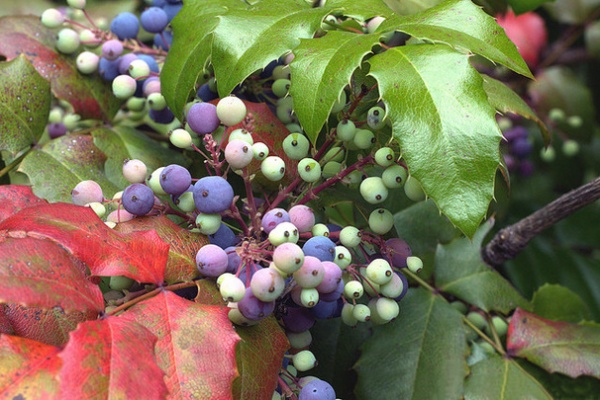
Botanical name: Mahonia aquifolium (syn. Berberis aquifolium)
Common names: Oregon grape, Oregon grape holly, hollyleaved barberry
Origin: California; some regions in Oregon, Washington, Idaho, Montana, British Columbia and northern Mexico; prohibited in Michigan due to black stem rust
Natural habitat: Slopes, canyons, coniferous forests, oak woodlands, chaparral; below 6,500 feet elevation
Where it will grow: Easily hardy to 15 degrees Fahrenheit (USDA zones 5 to 9; find your zone)
Water requirement: Drought tolerant to needing occasional water
Light requirement: Full sun along the coast; partial shade inland
Soil: Adaptable; prefers acidic, well-drained soil
Mature size: 3 to 6 feet tall and 4 feet wide; spreads slowly
Benefits and tolerances: Benefits birds and butterflies; tolerates coastal conditions, clay, drought and desert; good with oaks; deer resistant; edible
Seasonal interest: Year-round interest, with spring flowers, bronze new foliage and fall colors, without dropping leaves; summer berries follow the bloom, ripening to dark purple in summer to fall
When to plant: Late fall is ideal; winter works well; spring is acceptable; summer can be challenging to all but the most experienced gardener
Photo by Manuel
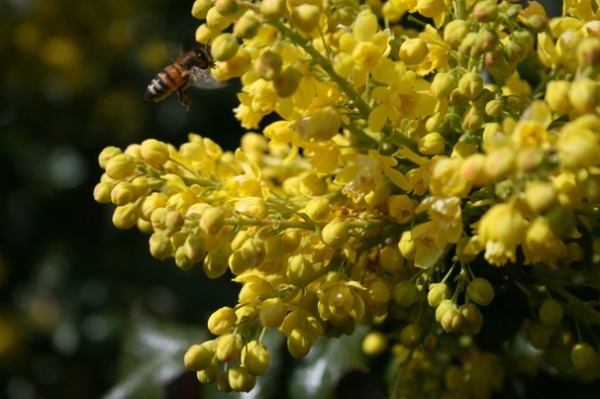
Distinguishing traits. Its vivid flowers, holly-like leaves and colorful fall display make Oregon grape a handsome architectural element that will lighten up any shady area. This evergreen provides food for birds, butterflies and all sorts of pollinators.
Photo by born1945
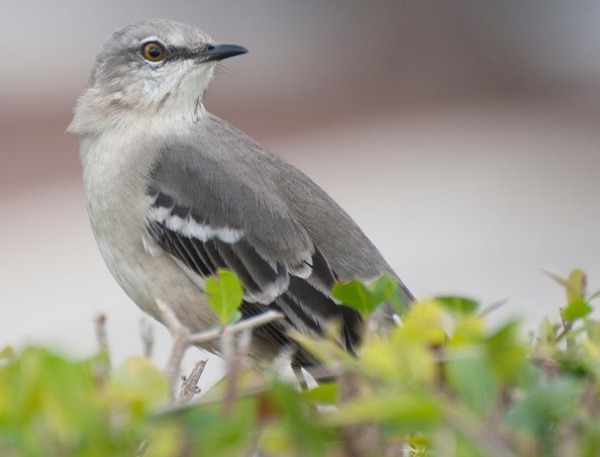
Wildlife value. Berry-eating birds, like California thrashers, American robins, California towhees and the handsome mockingbird seen here, find the fruit to be a tasty meal. Many species of birds hide and perch in the foliage. If there’s a bit of warm sun, bumblebees, butterflies and other pollinators will sip the nectar and feed on the pollen. In turn, the insects attracted to Oregon grape can become lunch for insect-eating birds.
Photo by vladeb
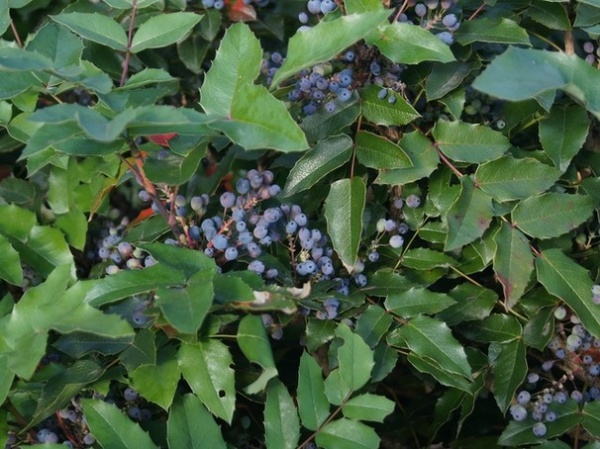
The spiny foliage makes Oregon grape perfect for landscapes with browsing deer. One poke in the nose and the deer stay away.
Photo by Tatters
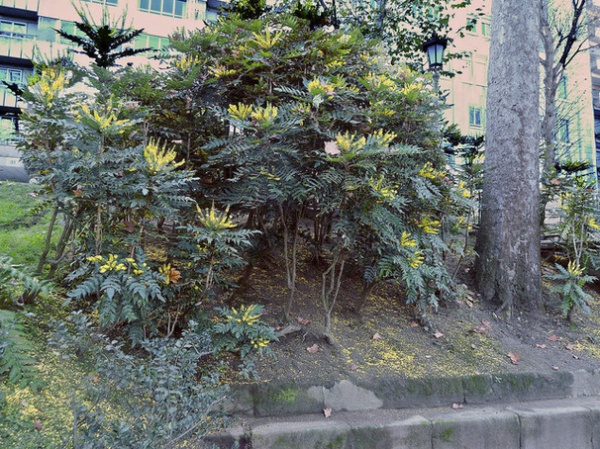
How to use it. Oregon grape makes an excellent hedge or specimen for a partly shaded area; it’s a great accent plant for a woodland garden.
The fruit is edible. Some say it is bitter and not worth bothering with, while others maintain that preserves and other recipes made with it are quite good. This will be for you to find out.
Photo by Nacho
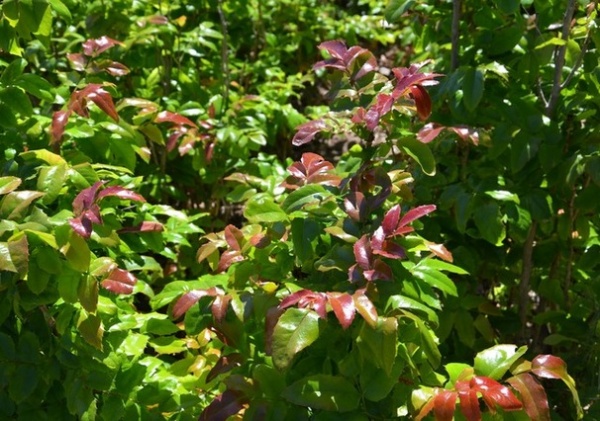
Another species. Creeping barberry (Mahonia repens, syn. Berberis aquifolium var. repens) is very similar to the Oregon grape shown here, yet it grows only to 2½ feet tall and slowly spreads to 3 to 5 feet wide, and is an ideal ground cover. It can handle a bit more summer water than Oregon grape, but extra water is not necessary, since creeping barberry is also drought tolerant. Its fruit hangs near the ground, so quail can easily pluck and then enthusiastically consume the berries. Creeping barberry also sports red and other colored leaves like those shown.
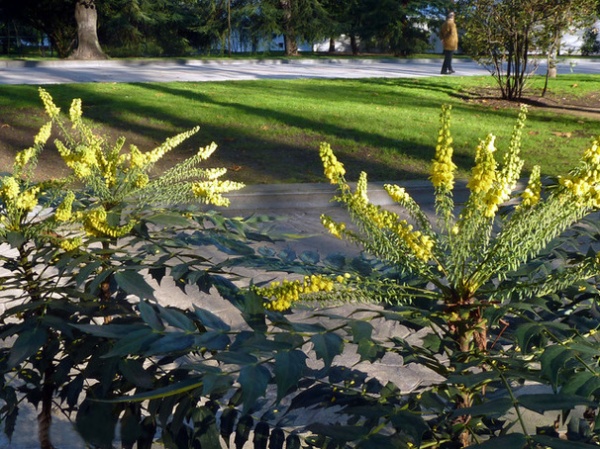
Planting notes. The height and shape of Oregon grape can be managed with light pruning. Once established, it can also be coppiced (cut to the ground) in the fall or winter to renew old growth or help control cabbage looper caterpillars. Tough and disease resistant, Oregon grape is also easy and low maintenance.
Photo by Nacho
More:
Browse plants native to other regions of the U.S.
8 Native Shrubs for Year-Round Bird Feeding












